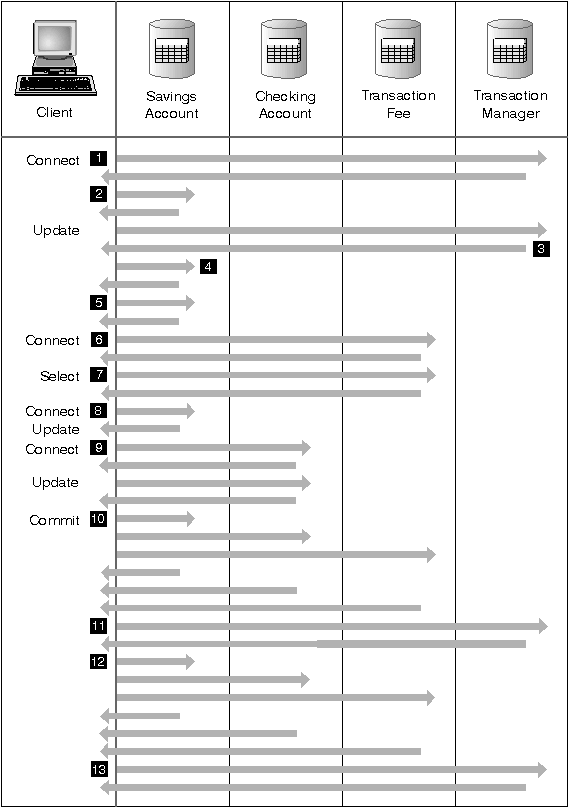
Administration Guide
The following example illustrates the steps of the example transaction
(described in "Updating Multiple Databases") and the participants in the transaction. If an error occurs during the
two-phase commit process, understanding how a transaction is managed will help
you to resolve the problem.
Figure 36. Updating Multiple Databases

|
- (1)
- When the database client wants to connect to SAVINGS_DB, it first connects
to the Transaction Manager (TM) database. The TM database returns an
acknowledgement to the database client.
- (2)
- The connection to the SAVINGS_DB takes place and is acknowledged.
- (3)
- The database client begins the update to the SAVINGS_ACCOUNT table. This
begins the unit of work. The TM database responds to the database client
providing a transaction ID for the unit of work. Note that the registration of
a unit of work occurs when the first SQL statement in the unit of work is run,
not necessarily during connect time.
- (4)
- After receiving the transaction ID, the database client registers the unit
of work with the database containing the SAVINGS_ACCOUNT table. A response is
sent back to the client to indicate that the unit of work has been registered
successfully.
- (5)
- SQL statements issued against the SAVINGS_DB are handled in the normal
manner. The response to each statement is returned in the SQLCA when working
with SQL statements embedded in a program. (The SQLCA is described in the Embedded SQL Programming Guide and the SQL Reference.)
- (6)
- The transaction ID is registered at the FEE_DB database containing the
TRANSACTION_FEE table, during the first access to that database within the
unit of work.
- (7)
- Any SQL statements against the FEE_DB database are handled in the normal
fashion.
- (8)
- Additional SQL statements can be executed against the SAVINGS_DB by
setting the connection as appropriate. Since the unit of work has already been
registered with the SAVINGS_DB (4), the database client does not need
to perform the registration step again.
- (9)
- Connecting to and using the CHECKING_DB follows the same rules as
described by (6) and (7).
- (10)
- When the database client requests that the unit of work be committed, a
prepare message is sent to all databases participating in the unit
of work. Each database writes a "PREPARED" record to their log files and
replies to the database client.
- (11)
- After the database client receives a positive response from all of the
databases, it sends a message to the transaction manager database to inform it
that the unit of work is now ready to be committed (PREPARED). The transaction
manager database writes a "PREPARED" record to its log file and sends a
reply to inform the client that the second phase of the commit process can be
started.
- (12)
- During the second phase of the commit process, the database client sends a
message to all participating databases to tell them to commit. Each database
writes a "COMMITTED" record to its log file and releases the locks that
were held for this unit of work. When the database has completed committing
the changes, it sends a reply to client.
- (13)
- After the database client receives a positive response from all
participating databases, it sends a request to the transaction manager
database to inform it that the unit of work has been completed. The
transaction manager database then:
- Writes a "COMMITTED" record to its log file, to indicate that the
unit of work is complete
- Replies to the client to indicate it has finished.
[ Top of Page | Previous Page | Next Page | Table of Contents | Index ]
[ DB2 List of Books |
Search the DB2 Books ]


